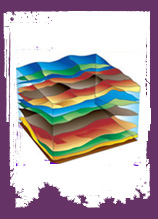Natural Gas ScienceNatural Gas Safety-SMART! Home
Searching for the Invisible
Imagine looking for buried treasure without a map. Now imagine that the treasure is also invisible. That's the challenge geologists face when exploring for natural gas.
Sometimes there are clues on the earth's surface. An oil seep is a possible sign of natural gas below, since oil and gas are sometimes found together. Geologists also have sensitive machines that can "sniff" surface soil and air for small amounts of natural gas that may have leaked from below ground.
But in order to get to the source of the natural gas, geologists need to find a gas trap—an underground rock formation that traps natural gas beneath it. The geologists start by mapping the surface of the ground. Then they use those maps to try to guess what the rocks below the surface look like.
 Geologists also conduct seismic surveys. They send sound waves into the ground and measure how fast the waves bounce back. This tells them how hard and how thick the different rock layers are underground. The data is fed into a computer, which draws a picture of the rock layers. This picture is called a seismogram. So, when geologists explore for natural gas, they aren't really looking for the gas, because the gas is invisible. They're looking for certain rock formations that might hold natural gas. Of course, the only way to be sure natural gas is down there is to drill a well.
Geologists also conduct seismic surveys. They send sound waves into the ground and measure how fast the waves bounce back. This tells them how hard and how thick the different rock layers are underground. The data is fed into a computer, which draws a picture of the rock layers. This picture is called a seismogram. So, when geologists explore for natural gas, they aren't really looking for the gas, because the gas is invisible. They're looking for certain rock formations that might hold natural gas. Of course, the only way to be sure natural gas is down there is to drill a well.




